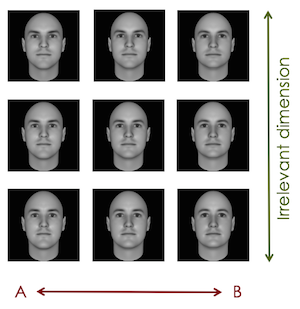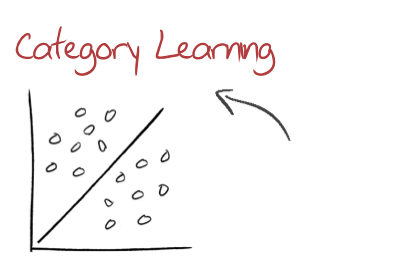
|

|
|
Category
Learning
[back]
Human and non-human animals are capable of grouping visual objects into
novel categories. A
growing body of evidence suggests that at least two category learning
mechanisms
may be available to people: a procedural learning system, implemented
by the circuitry of the basal ganglia, and a rule-based learning
system, implemented in the prefrontal cortex.
Learning of representations
that support rule learning
 Fast, accurate, and generalizable categorization of novel objects
depends on the ability to extract some information from the objects
that is relevant for a task, while completely ignoring other
information irrelevant for the task. Such performance is only possible
when the known representation of relevant information (the “relevant
dimension”) is independent from the known representation of irrelevant
information (the “irrelevant dimension”), so that processing of
irrelevant information does not interfere with processing of relevant
information. This means that the key to understand fast, accurate and
generalizable object category learning is a better understanding of how
independent object dimensions are learned from experience and used in
categorization tasks. However, very little is known about such
processes. Fast, accurate, and generalizable categorization of novel objects
depends on the ability to extract some information from the objects
that is relevant for a task, while completely ignoring other
information irrelevant for the task. Such performance is only possible
when the known representation of relevant information (the “relevant
dimension”) is independent from the known representation of irrelevant
information (the “irrelevant dimension”), so that processing of
irrelevant information does not interfere with processing of relevant
information. This means that the key to understand fast, accurate and
generalizable object category learning is a better understanding of how
independent object dimensions are learned from experience and used in
categorization tasks. However, very little is known about such
processes.
Using multidimensional signal
detection theory
to measure perceptual
independence, we have found that categorization training produces
learning of novel separable dimensions. We recently asked whether
newly-learned dimensions support the kind of rule-based category
learning observed with traditional separable dimensions (Soto & Ashby, 2018).
Surprisingly, we found that extensive categorization training is not
necessary for rule-based category learning. Instead, representations
that support the use of rule-based learning seem to be acquired
on-the-fly during categorization training with stimuli that lack a
previous dimensional structure. It seems as if people have a
predisposition to learn categorization tasks using rule-based
strategies, even when stimuli are not represented in a way that would
facilitate such learning.
|
|
|
|


 Fast, accurate, and generalizable categorization of novel objects
depends on the ability to extract some information from the objects
that is relevant for a task, while completely ignoring other
information irrelevant for the task. Such performance is only possible
when the known representation of relevant information (the “relevant
dimension”) is independent from the known representation of irrelevant
information (the “irrelevant dimension”), so that processing of
irrelevant information does not interfere with processing of relevant
information. This means that the key to understand fast, accurate and
generalizable object category learning is a better understanding of how
independent object dimensions are learned from experience and used in
categorization tasks. However, very little is known about such
processes.
Fast, accurate, and generalizable categorization of novel objects
depends on the ability to extract some information from the objects
that is relevant for a task, while completely ignoring other
information irrelevant for the task. Such performance is only possible
when the known representation of relevant information (the “relevant
dimension”) is independent from the known representation of irrelevant
information (the “irrelevant dimension”), so that processing of
irrelevant information does not interfere with processing of relevant
information. This means that the key to understand fast, accurate and
generalizable object category learning is a better understanding of how
independent object dimensions are learned from experience and used in
categorization tasks. However, very little is known about such
processes.







